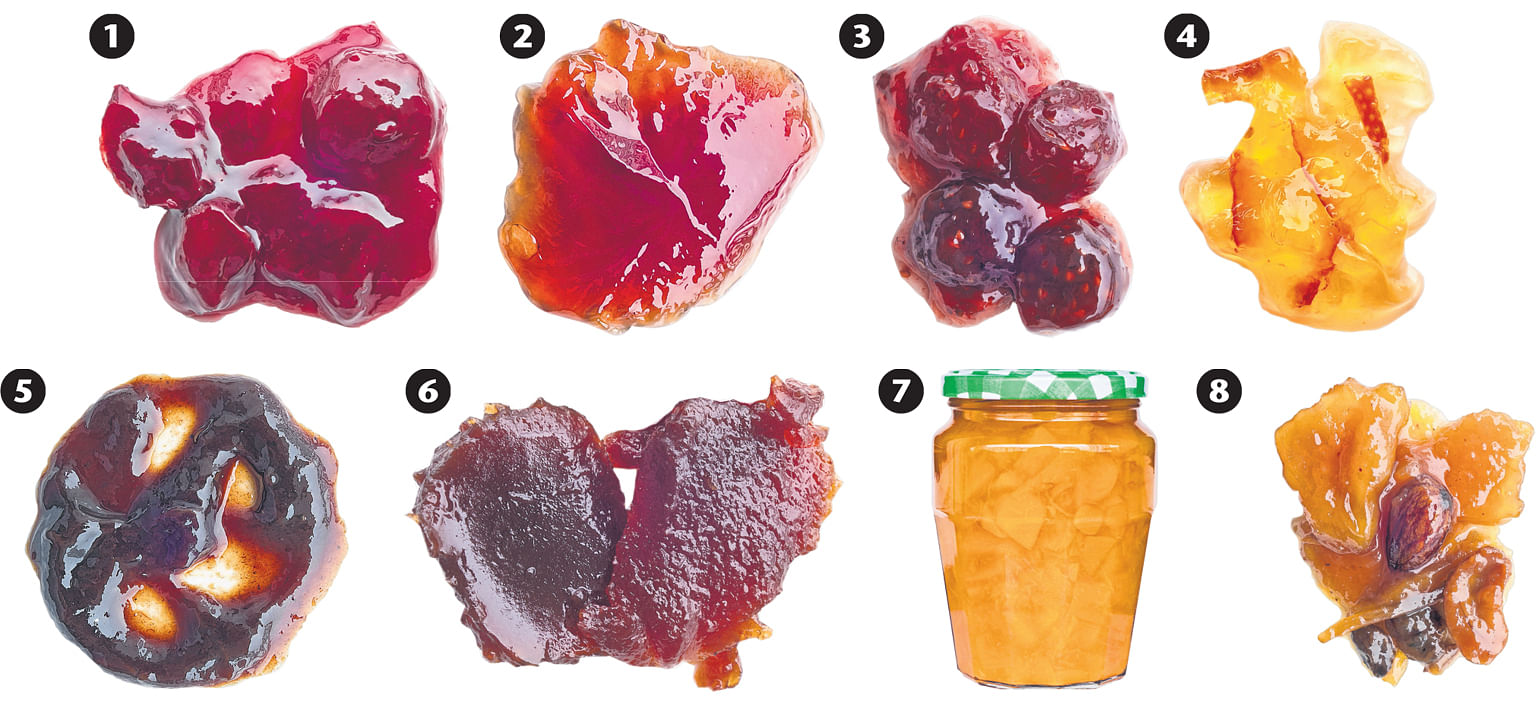Similar-looking glass jars hold diverse contents. Here is a guide to jams and related preserves.
• Definitions: A fruit preserve contains chiefly fruit and sugar, the latter sometimes replaced by other sweeteners such as concentrated fruit juice and the sugar substitute Stevia. Labelling standards for the preserve types listed below often differ considerably between different countries, depending on the ingredients and ratios used.
• Pectin: A gelling agent found in all fruit. It is released upon prolonged cooking and forms a gel in sugary and acidic conditions. Citrus fruit, apples, quinces, guavas and some berries are especially pectinrich. The thickness and solidity of a preserve depends highly on the pectin content.
• Jam: A wide term typically referring to a spreadable preserve made with a single fruit variety, or occasionally two or more kinds of fruit. Most jams contain between 35 and 55 per cent fruit. Those with a higher fruit content, such as the 70 per cent fruit sour cherry jam shown here (photo 1), may be labelled "extra".

• Jelly: Fruit cooked with sugar and sometimes added pectin until the juices are released, then strained through a very fine cloth or sieve without applied pressure. The idea is to obtain a clear liquid that sets into a transparent or translucent preserve. Shown here is redcurrant jelly (photo 2), a traditional British accompaniment for roast meats and game.
• Conserve: This has two definitions. The first is a preserve containing a single fruit type, whole or in large chunks, carefully cooked to retain shape and succulence; and the second is a thicker preserve made from two or more fruit types, often a mix of fresh and dried fruits, and sometimes also nuts and/or spices. Shown here is a strawberry conserve of the first kind (photo 3). In Greece and parts of Europe, some traditional conserves are called "spoon sweets" as they are served in small spoons to be savoured on their own.
• Marmalade: In English, the name given to citrus fruit preserves. Its equivalent in other languages, such as the Italian "marmellata", may also cover other fruit preserves. Usually distinguished by pieces of citrus peel, which give it a bittersweet flavour. Classic orange marmalade (photo 4) is made with Seville oranges, whose pectin-rich and very aromatic peel yields a firmly set, fragrant preserve.
• Fruit butter: Dairy-free preserves named for their thickly spreadable texture, made by cooking down fruit and sugar without added pectin. Typically, succulent rather than watery fruits are used, such as apples, pears and stone fruit. Damson plum butter is shown here (photo 5).
• Fruit paste: Fruit puree cooked with sugar until thick enough to set into a firm slab when cooled. In Britain, it is traditionally called "fruit cheese". In France, it is called pate de fruit. Shown here is quince paste (photo 6), enjoyed in many parts of Europe and Latin America. Many fruits can be made into pastes with the help of added pectin.
• Compote: Whole or coarsely cut fruit poached in light syrup until tender. Most often eaten fresh, they may be bottled and processed for longer keeping, such as the peach compote shown here (photo 7).
• Chutney: Chutneys differ from jams and conserves (sometimes quite minimally) by also containing spices, salt and acidic ingredients such as vinegar or tamarind. Western chutneys derive from AngloIndian versions of the Indian originals and run a wide gamut of textures and flavours. The fruit and nut chutney shown here (photo 8) contains mango, pumpkin, apple, raisins, ginger, almonds and cashew nuts.
Text and photos: Chris Tan
